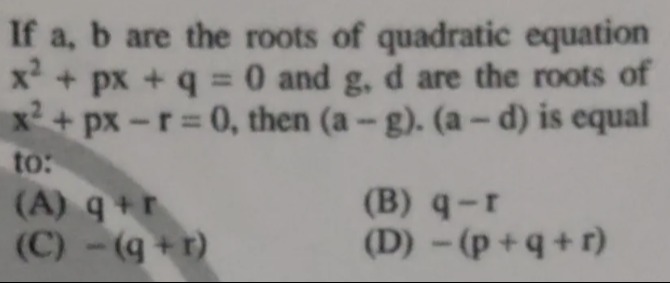Question
Question: If a, b are the roots of quadratic equation $x^2 + px + q = 0$ and g, d are the roots of $x^2 + px -...
If a, b are the roots of quadratic equation x2+px+q=0 and g, d are the roots of x2+px−r=0, then (a - g). (a - d) is equal to:

q+r
q-r
- (q+r)
-(p+q+г)
-(q+r)
Solution
Let the given quadratic equations be:
- x2+px+q=0, with roots a and b.
- x2+px−r=0, with roots g and d.
From the properties of roots of a quadratic equation, for the second equation x2+px−r=0, the roots are g and d. This means that the polynomial x2+px−r can be factored as (x−g)(x−d). So, for any value of x, we have: x2+px−r=(x−g)(x−d)
We are asked to find the value of (a−g)⋅(a−d). This expression is the value of the polynomial (x−g)(x−d) when x=a. Substituting x=a into the equation x2+px−r=(x−g)(x−d), we get: a2+pa−r=(a−g)(a−d)
Now, we use the information about the first equation. The roots of x2+px+q=0 are a and b. Since a is a root of the equation x2+px+q=0, it must satisfy the equation. So, substituting x=a into the first equation, we get: a2+pa+q=0
From this equation, we can express a2+pa as: a2+pa=−q
Now, substitute this value of a2+pa into the expression for (a−g)(a−d): (a−g)(a−d)=(a2+pa)−r (a−g)(a−d)=(−q)−r (a−g)(a−d)=−(q+r)
Thus, the value of (a−g)⋅(a−d) is −(q+r).
